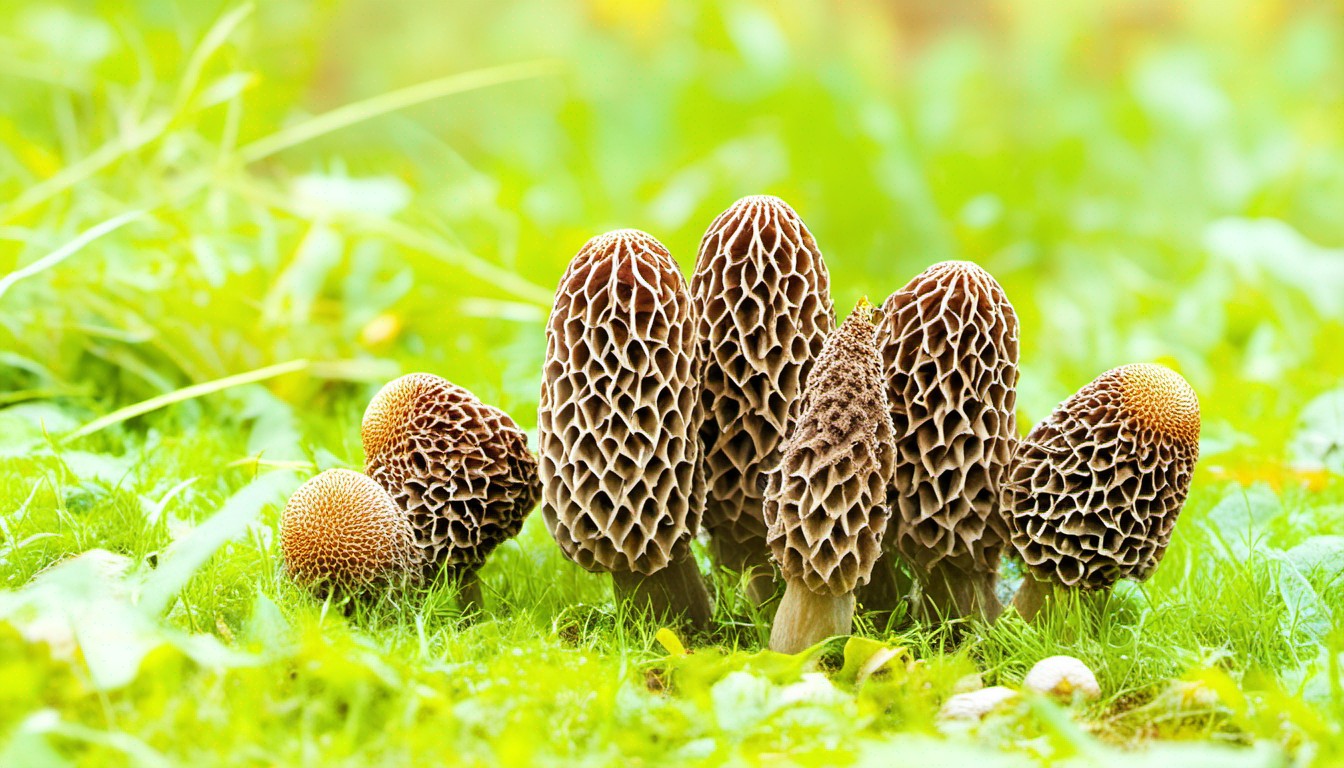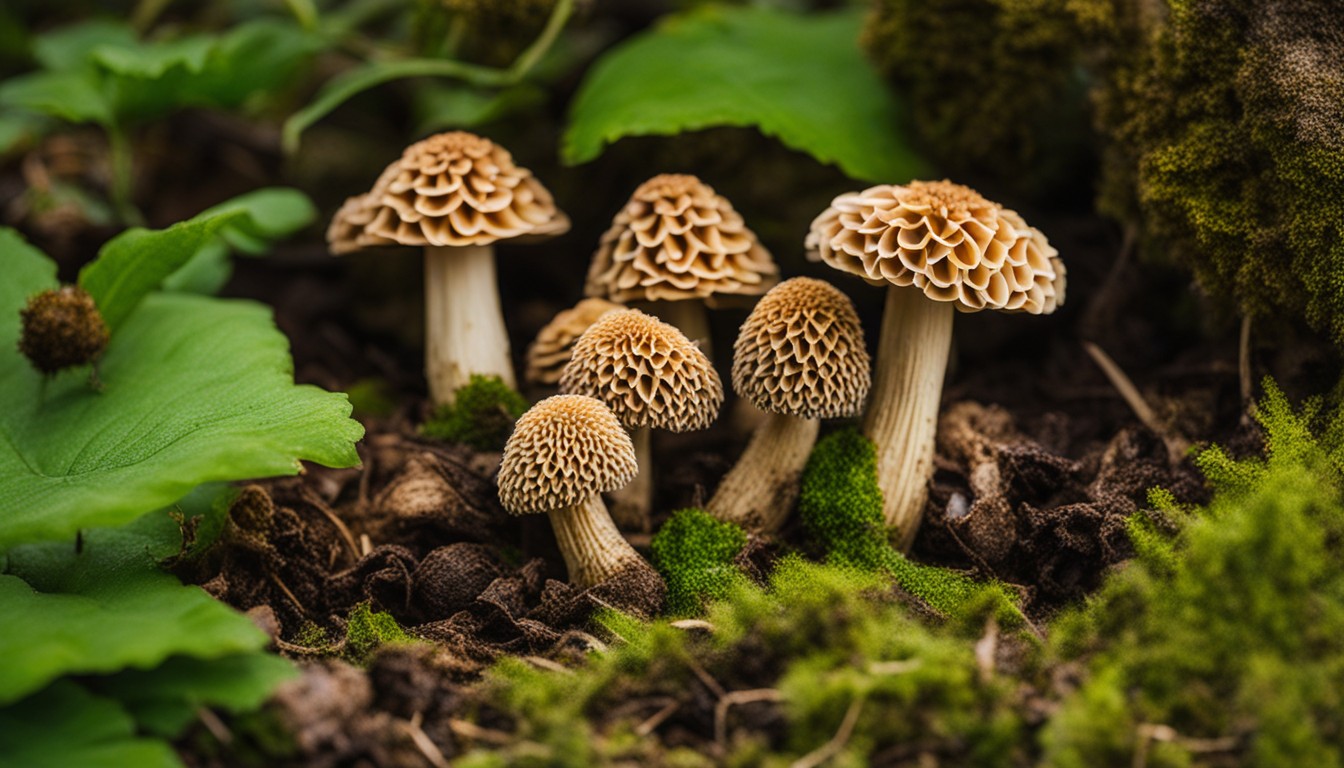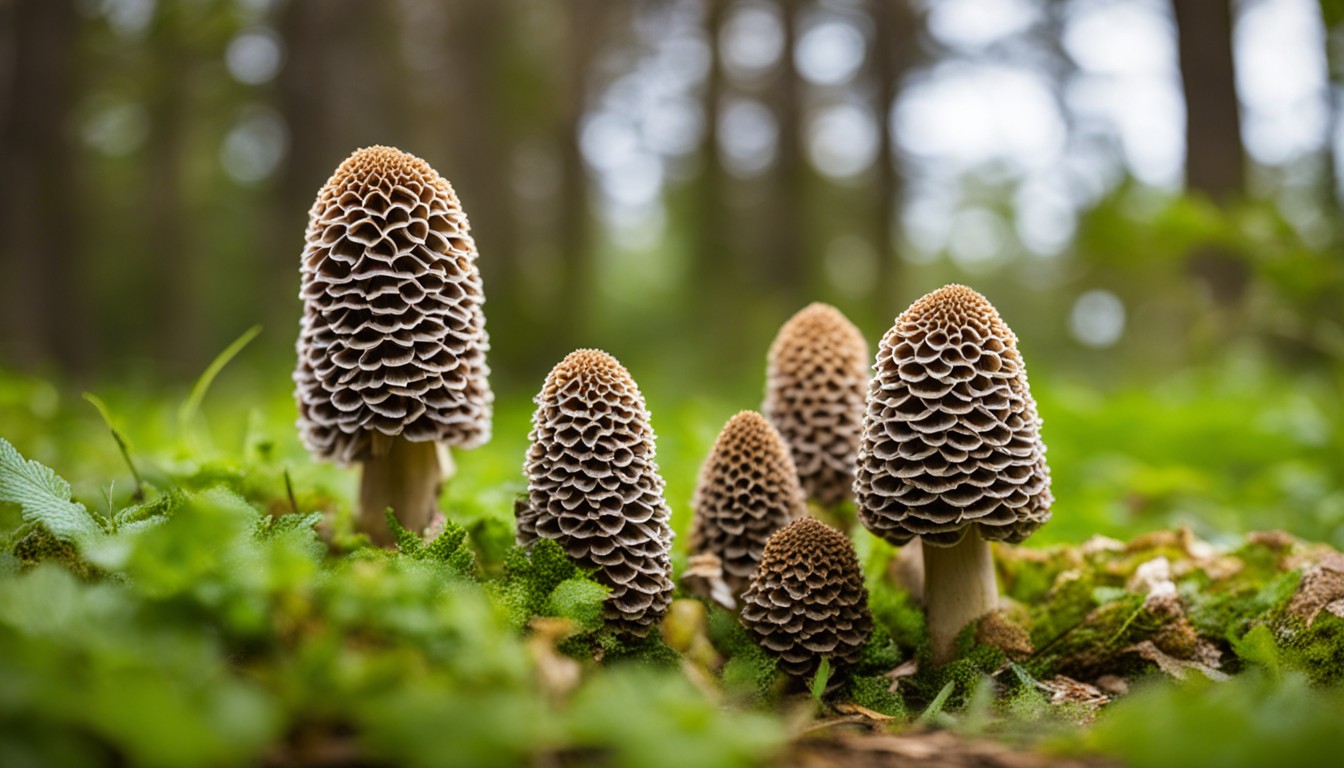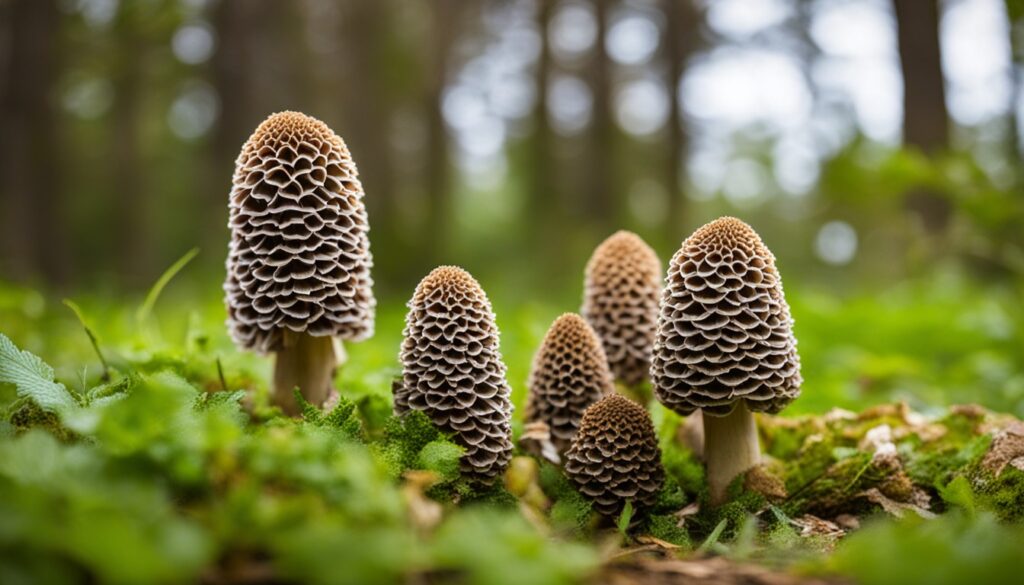Morel mushrooms are a prized delicacy known for their unique shape and rich flavor. In Tennessee, these elusive fungi can be found in various wooded areas, particularly during the spring season. Foraging for morel mushrooms requires a keen eye and knowledge of their preferred habitats, such as moist forests and riverbanks. This guide will provide valuable tips and techniques for successfully locating and harvesting morel mushrooms in Tennessee, ensuring a rewarding and delicious foraging experience.
The Basics of Morel Mushrooms
Morel mushrooms belong to the Morchella genus and are prized for their rarity and delicious taste. Three common types include the yellow morel, black morel, and half-free morel, each with distinct features and habitats in Tennessee.
It is paramount to differentiate morels from dangerous look-a-likes, such as the toxic false morel. Morels possess a honeycomb-like cap that is completely attached to the stem, unlike common fungi that frequently have separate cap and stem structures.
What are Morel Mushrooms?
Morel mushrooms, or Morchella, are a genus of edible sac fungi esteemed for their unique honeycomb-like structures. These unusual fruiting bodies, along with their subtly earthy flavor and meaty texture, make them distinctive in the world of fungi.
Morels, with their honeycomb-like structures and earthy flavor, often sprout seasonally near trees that have recently suffered fire or disease, making their brief appearance a culinary event.
Intriguingly, Morel mushrooms have a lifecycle characterized by a brief, seasonal appearance. They typically sprout in the spring, following a cycle of soil warming and rainfall, and surprisingly, often near trees recently damaged by fire or disease.
Why Are Morel Mushrooms Special?
Morel mushrooms are esteemed in gastronomic circles for their earthy, meatlike flavor and delicate texture. These characteristics have made morels a prized ingredient in gourmet dishes worldwide, contributing to their popular demand among food enthusiasts and professional chefs alike. Morels, with their unique taste and culinary uses, hold a distinct place in the mushroom kingdom.
The scarcity and elusive nature of morel mushrooms also add to their allure. They cannot be easily cultivated like other mushrooms, making their wild counterparts a sought-after delicacy. Each Morel mushroom season is eagerly anticipated not just for the delight of finding these fungi but also for the culinary delights that follow.
Beyond their gastronomic value, Morel mushrooms contribute significantly to the ecosystem. They play a crucial role in nutrient cycling by decomposing organic matter and contribute to soil fertility. This aids in the overall health and productivity of the forests where they grow.
Furthermore, Morel mushrooms form symbiotic relationships with trees, enhancing their ability to absorb water and nutrients. This reflects their important ecological roles, beyond their culinary applications. These factors highlight the importance of sustainable and responsible foraging practices to keep the population and habitat of Morel mushrooms healthy.
When and Where Can You Find Morel Mushrooms in Tennessee?
Predicting Morel Mushroom growth patterns in Tennessee can be a game of chance. They typically sprout in spring when temperatures reach between 60-70 degrees Fahrenheit and rain has moistened the soil.
Morel Mushrooms in Tennessee are often found around dying or dead elm, ash, and apple trees. These fungi establish a symbiotic relationship with the roots of these trees, favoring nutrient-rich and well-drained soils.
Topographically, Morel Mushrooms are found throughout Tennessee’s diverse landscape. Fertile river valleys, such as those found in the Western Highland Rim, provide ideal conditions for these elusive fungi.
While Morel Mushrooms can be discovered throughout the state, higher concentrations are often found in the eastern and northeastern regions of Tennessee. This is due to the cooler, humid climate and higher precipitation levels that are prevalent in these areas.
Identifying Morel Mushrooms

Unveiling a Morel mushroom requires keen eyes and sharp senses. Spotting a Morel is like unearthing a jewel from nature’s realm – it comes with a unique honeycomb-like exterior, usually elongated or oval in shape, and a hollow interior when sliced open.
While foraging for Morel mushrooms, safety should remain at the forefront. Equipped with a sturdy, breathable bag for collection, a detailed field guide for identification, and wearing appropriate clothing, mushroom hunters can ensure a bounty of morels without risking misidentification or harm to the ecosystem.
Distinctive Features of Morel Mushrooms
Morel mushrooms bear a distinct anatomy that makes them easily recognizable. In Tennessee, these fungi are renowned for their honeycomb-like caps and slender, often bent stems, which lend them a unique, somewhat alien appearance.
A comprehensive understanding of Tennessee Morels entails recognizing their common characteristics. These include their caps’ ridges, which are dark, while the pits in-between are often lighter. Their height typically ranges from 2 to 12 inches, and they possess a distinctive nutty flavor.
Similar Mushroom Species to Watch Out For
Morels can be easily confused with similar species, particularly to beginners. The Volutipes and Verpa genera, also known as the false morels, closely resemble morels, prompting the necessity for extreme caution.
Key identifying features separate true Morels from their somewhat dangerous counterparts. Morels have a honeycomb-like cap connected at the base to the stem while false morels often have a cap hanging freely from the top or part of the stem.
In case of Verpa genus, the spores are borne inside of a sac, whereas in Morels they are on the surface. Experienced morel hunters develop the ability to distinguish these subtle differences.
Extra vigilance is required in Tennessee due to the close likeness of Gyromitra species to Morels. The consumption of some Gyromitra species can lead to fatal outcomes. Carry a field guide or consult a local expert if you are uncertain of your findings.
Preparing for a Morel Foraging Trip
Any successful Morel foraging trip in Tennessee requires thorough preparation. You must understand local regulations, gather necessary equipment, and heed essential safety precautions.
Your Tennessee Morel Mushroom foraging trip will be determined by careful planning. Knowledge about where and when to look for Morels, combined with alertness to their seasonal patterns and environmental cues, ensures a fruitful hunt.
Researching Morel Mushroom Hunting Regulations
With Tennessee’s rich biodiversity, the state has implemented some specific laws related to morel mushroom hunting. An essential first step before planning a morel foraging trip should involve familiarizing yourself with these regulations.
Tennessee’s foraging policies might seem complex but they are primarily designed to protect the biodiversity and ensure sustainable practices. Understanding these can not only prevent legal issues, but also promote ecosystem health.
Possession limits, picking methods, and permissible locations are a few key aspects covered by these guidelines, with differences noted for private versus public land. You would be expected to adhere to these regulations to ensure seamless hunting experience.
Tennessee Department of Environment and Conservation is a reliable source for researching these regulations. Often, wildlife refuges and state parks have their own rules, so contacting them directly is advisable as well.
Do take note that violation of these laws can lead to fines or penalties, marking the significance of a comprehensive understanding of the legalities involved in morel mushroom hunting in Tennessee.
Gathering the Right Supplies and Tools

As with any foraging trip, a good checklist of tools and supplies can significantly enhance your Morel hunting experience. These include suitable clothing for the local climate, comfortable hiking shoes, a topographic map of your chosen hunting area, and a sturdy bag or basket for collected mushrooms.
Specialized tools can greatly assist in successful forage. These could include a mushroom identification guide, a small knife for clean cuts, and a soft brush for removing excess dirt.
A key tool for Morel Mushroom foraging in Tennessee is your smartphone. Not only can it aid in mapping your route, but apps specific to mushroom hunting can help confirm your identifications and log your findings.
Lastly, always remember to take plenty of water and some high-energy food snacks. Foraging can be a physically demanding task, and keeping yourself well-hydrated and nourished is essential. A basic first aid kit should also be part of your supplies for any unexpected incidents.
Safety Precautions to Keep in Mind
A forager’s safety holds paramount importance while hunting for Morel Mushrooms in Tennessee. Hazardous conditions such as unstable terrain, harmful insects, and poisonous plants are common and need proper attention.
Knowledge on addressing safety hazards during Morel Mushroom hunts is imperative. Be it allergic reactions to certain plants or insects or mitigating threats from treacherous weather conditions, having a first-aid kit and arming oneself with proper information is crucial.
Stay in defined paths as much as possible and always communicate your location to someone close. Do not forage alone, moreover, familiarize yourself with local wildlife and potential hazards. Care in these regards does not merely ensure safety but can also augment the success of a Morel hunt.
Tips for Successful Morel Mushroom Foraging
Successful Morel foraging in Tennessee demands practical knowledge. Familiarize yourself with optimal conditions, such as post-rain and spring seasons, for Morel growth. A keen understanding of the Morels’ affinity for apple, elm, and ash trees empowers your hunt.
To maximize yield, explore multiple habitats. Morels flourish not only in forests but also in disturbed grounds such as burn sites and flood zones. Adopt a systematic approach; start from the perimeter and work inward, carefully combing each square foot for these elusive fungi.
Scouting the Right Locations
In the pursuit of Morel Mushrooms in Tennessee, scouting the right locations is foundational for a fruitful forage. Understanding the natural landscape and environment is key to identifying potential Morel hotspots in the state.
- Educate yourself on where Morel mushrooms commonly thrive such as areas with limestone outcrops, near dead or dying Elm and Ash trees, and old apple orchards.
- Understand that Morel mushrooms often grow plentifully around burned areas or recently disturbed lands.
- Consider areas with a mix of sunlight and shade, as these environments can sometimes provide ideal conditions for Morel growth.
- Using a topographic map can be beneficial when planning your mushroom hunt, these maps can highlight the type of geography Morels could potentially favor.
- Integrate the use of GPS to mark successful foraging spots; this aids in mapping your hunt and can potentially increase productivity in future excursions.
Observing Environmental Conditions
Morel mushrooms in Tennessee have an affinity for specific environmental conditions. Grasping both weather patterns and soil conditions is integral to improving foraging outcomes.
- Evaluate weather patterns: Morels tend to appear after the soil warms and steady rainfall occurs.
- Analyze soil temperatures: Morels favor soil temperatures around 50 to 58 degrees Fahrenheit.
- Observe the amount of rainfall: A period of wet weather followed by a drastic warming trend often prompts morel growth.
- Take stock of soil composition: Loamy, well-drained soil rich in calcium is preferred by morels.
Exploring Different Habitats
Varying habitats in Tennessee, such as woodlands, wetlands, and farmlands, significantly impact the growth of Morel Mushrooms. Studying and exploring these diverse biomes escalates your chances of a successful Morel foraging.
- Examine woodland areas, especially near dying or dead trees.
- Explore river valleys and wetland regions)
- Investigate farmlands or pastures, particularly those with a history of fires
- Search in apple orchards and burn sites
- Survey limestone-rich areas
- Look around old apple trees
- Inspect areas that have been disturbed mechanically (construction sites, logging)
- Consider searching cottonwood tree plantations
Understanding Morel Mushroom Seasons

In Tennessee, understanding the seasons of Morel Mushrooms involves deciphering their unique seasonal cycles, profoundly influenced by the state’s climate variations. This understanding helps foragers in predicting the optimal time for successful mushroom hunting.
- Recognizing the onset of Spring as the best period for Morel foraging: late March to early May.
- Understanding that warmer temperatures initiate Morel spore germination.
- Noticing that after periods of rain and damp conditions, Morels are likely to flourish.
- Realizing that late freezes can kill emerging Morels.
- Recognizing variations in elevations across Tennessee can change local Morel seasons.
Harvesting and Handling Morels
Utilizing scientific understanding of morels, it’s essential to adopt techniques such as twisting then pulling gently from the base, which allow for efficient harvesting. This practice not only keeps the morel intact but fosters the regrowth of new mushrooms.
Handling morel mushrooms requires delicacy; they are prone to bruising, impacting their taste and shelf-life. Rapid temperature changes can spoil them. Thus, store them in a cool, dry place in a breathable bag, minimizing unnecessary handling to promote optimum preservation.
Picking Morel Mushrooms Correctly
Sustainable Morel Mushroom picking entails several important considerations. Make each foraging trip as eco-friendly as possible by causing minimal disturbance to the natural habitat. When harvesting morels, pinch or cut them off just above the soil, preserving their delicate mycelium, the lifeline for future growth.
Picking morels is an art in itself, mastering it significantly ups your chances of a successful forage. A keen eye for detail is essential. Look not just for the mushroom but for signs of its presence, like indicative vegetation and favorable soil conditions.
Remember, it is crucial for morel mushrooms to mature before you pick them. By waiting, you’re allowing spores to be released, ensuring a healthy population for years to come. Patience is not just a virtue, it is a requirement for sustainable morel picking.
Meticulously practice the ‘leave no trace’ philosophy during your morel mushroom hunt. Disturbing, harming, or removing other flora and fauna must be avoided at all times. Respect for the ecosystem undeniably assures the continued prosperity of morels in Tennessee.
Careful handling is another pivotal aspect of mushroom picking. Morels are delicate and must not be squeezed or crushed in transit. Instead, carry a mesh bag or a basket, allowing the spores to disperse en route, unintentionally planting the seed for your next hunt.
Properly Storing and Transporting Morel Mushrooms
To maintain the freshness of Morel Mushrooms during transportation, it’s advisable to use breathable containers such as paper or mesh bags. These materials help to maintain the mushrooms’ natural moisture and prevent them from becoming slimy or soggy. Avoid using plastic bags that can create a moister environment, fostering bacteria and speeding up decay.
Temperature plays a critical role in the preservation of Morel Mushrooms. Store them in a refrigerator, preferably between 32° and 40°F. At these temperatures, the mushrooms will retain their freshness and flavor for up to one week.
It’s important to remember that morels, like all mushrooms, are highly perishable and should not be washed until they’re ready to be used. Washing too soon can introduce unnecessary moisture, which negatively impacts their texture and taste. Instead, use a dry, soft brush to gently remove any dirt or debris.
Finally, if planning to store Morels for an extended period, consider drying or freezing techniques. Preparing and properly packing the mushrooms before storing, will ensure they retain their delicious earthy flavor and unique texture, ready to be enjoyed out of season.
Morel Mushrooms in Tennessee: FAQ
Discover the allure of Morel mushrooms in Tennessee and become an expert in finding, identifying, and preserving this elusive culinary gem.
How do I find Morel mushrooms in Tennessee?
To find Morel mushrooms in Tennessee, search in moist forests, riverbanks, and areas with decaying vegetation during the spring season. Look for distinctive cone-shaped mushrooms with a honeycomb-like texture.
What do Morel mushrooms in Tennessee look like?
Morel mushrooms in Tennessee have a unique and distinctive appearance. They are cone-shaped with a pitted or honeycomb-like texture. They can vary in color from light tan to dark brown.
Are Morel mushrooms in Tennessee safe to eat?
Yes, Morel mushrooms in Tennessee are safe to eat when properly identified. However, it is crucial to correctly identify them, as there are poisonous mushrooms that resemble Morels. If in doubt, consult an experienced forager or mycologist for proper identification.
How do I harvest Morel mushrooms in Tennessee?
To harvest Morel mushrooms in Tennessee, gently cut the mushrooms at the base of the stem using a sharp knife or scissors. Be careful not to disturb the surrounding soil or vegetation. It is recommended to leave some mushrooms behind to allow for their spores to disperse and ensure future growth.
Can Morel mushrooms in Tennessee be preserved?
Yes, Morel mushrooms in Tennessee can be preserved. They can be dried, frozen, or pickled for later use. Drying Morels is a popular preservation method, either by air drying or using a food dehydrator. Proper storage in airtight containers will extend their shelf life.
Are there any restrictions or permits for foraging Morel mushrooms in Tennessee?
Always check local regulations and permits regarding foraging for mushrooms in Tennessee. Some areas may have restrictions or require permits for foraging. It is important to respect private property and obtain proper permissions when foraging on private land.
Can I sell Morel mushrooms in Tennessee?
Selling foraged Morel mushrooms in Tennessee may have specific regulations and requirements. It is advisable to research and comply with local laws and regulations to ensure compliance when selling mushrooms.
What are some popular recipes using Morel mushrooms from Tennessee?
Morel mushrooms from Tennessee can be used in a variety of culinary dishes, from simple sautés to gourmet preparations. Some popular recipes include Morel risotto, Morel cream sauce for pasta or steak, and stuffed Morel mushrooms. Explore the possibilities and let your creativity shine in the kitchen!
Remember, always exercise caution when foraging for mushrooms, and when in doubt, consult with an expert or experienced forager for proper identification and guidance. Enjoy the thrill of finding and savoring the delectable Morel mushrooms in Tennessee!
Conclusion
Foraging Morel Mushrooms in Tennessee is a rewarding endeavor filled with joy and challenges. It’s a journey that starts with understanding the basics of Morels, their unique features, and preferred habitats, right through to observing environmental conditions, and ensuring correct harvesting, handling, and storage techniques.
- Understanding Morel Mushrooms
- Identifying Morel Mushrooms
- Researching Morel Mushroom regulations
- Gathering the right supplies
- Observing Environmental conditions
- Exploring habitats
- Understanding Morel Mushroom seasons
- Successfully picking and storing Morels.

